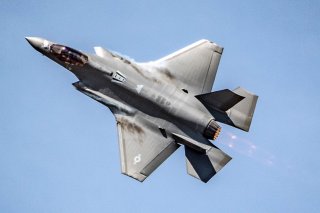GE Completes Testing New, More Powerful F-35 Stealth Fighter Engine
Though retooling the F-35’s engines could offer advantages, it might leave the F-35B behind.
In a press release, General Electric announced the conclusion of testing for their F-35 fighter jet engine replacement program. This initiative seeks to boost the F-35 stealth fighter’s performance by affording the warplane greater range, acceleration, and an increased combat radius.
“This is the culmination of more than a decade of methodical risk reduction and testing GE has completed with the Air Force across three different adaptive cycle engine programs,” said David Tweedie, GE Edison Works’ vice president and general manager for Advanced Products, in a statement released by General Electric.
“The engine performance data we gathered at AEDC continued to show the XA100’s transformational capability, while also demonstrating a return on substantial Air Force and taxpayer investment,” he added. “We now stand ready to transition to an Engineering and Manufacturing Development program and bring this engine to the field with the F-35 before the end of this decade.”
“This engine isn’t a concept, proposal, or research program. This is a flight-weight, highly product-relevant engine that would provide the F-35 with 30% more range, greater than 20% faster acceleration, and significant mission systems growth to harness the F-35’s full capabilities for Block 4 upgrades, and beyond,” Tweedie explained.
“The XA100 is the only F-35 propulsion modernization option that has been built, fully tested, and evaluated against Air Force performance targets, and the only option that provides the Air Force the capability it needs to outpace its adversaries for decades to come.”
The General Electric statement explained that compared to the engines that currently power the F-35, their adaptive cycle engine provides a significant boost. “These revolutionary innovations increase thrust more than 10%, improve fuel efficiency by 25%, and provide significantly more aircraft heat dissipation capacity, all within the same physical envelope as current propulsion systems,” the company statement explained.
It added that “GE’s engine is uniquely designed to fit in the F-35A, as well as the F-35C without modifications to the tailhook. The XA100’s improved fuel efficiency provides a significant reduction in carbon emissions and will operate on any U.S. Air Force-approved Sustainable Aviation Fuel.”
While mating the new engine to the F-35A and F-35C variants would likely be relatively straightforward, it remains to be seen if the new engine could be paired with the F-35B, the short take-off and vertical landing variant flown by the United States Marine Corps.
Unlike the A and C variants, the F-35B’s engine is significantly different. It incorporates a large central fan in its design that allows the airplane to land independently of a runway—and operating a fleet of fifth-generation stealth fighters with multiple engines, different components, and differing maintenance schedules could prove to be a headache.
Caleb Larson is a multimedia journalist and defense writer with the National Interest. A graduate of UCLA, he also holds a Master of Public Policy and lives in Berlin. He covers the intersection of conflict, security, and technology, focusing on American foreign policy, European security, and German society for both print and radio. Follow him on Twitter @calebmlarson
Image: Reuters.

